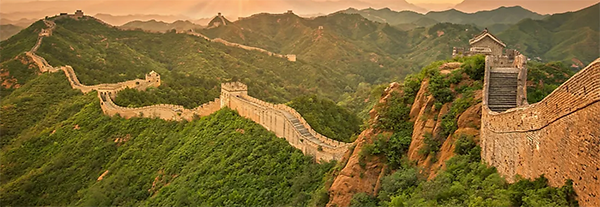
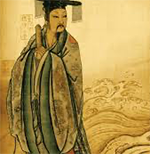 The Chinese civilization is one of Earth's oldest, dating back thousands of years. It wasn't always ruled by dynasties, but it was those dynasties who gave the civilization stability, to a greater or lesser degree, for most of its existence. The first dynasty to rule a number of Chinese people was the Xia, who ruled from 2070 B.C. to 1600 B.C. in what is today Henan Province. The founder of this dynasty was Yǔ the Great, who was well-known in Chinese history for his efforts to overcome the devastating Huang He flooding. One famous saying was "But fo Yǔ, we would all be fishes." Under Yǔ's reign, he and other wealthy people lived in developed areas, and poorer people lived in rural areas. The people of this time made things of many shapes out of bronze. Yǔ decreed that his son, Qǐ, would succeed him as ruler, and this happened. Xia rulers so followed their fathers until 1600, when the Xia ruler Jiè found defeat at the Battle of Mingtiao, at the hands of Tang, from the kingdom of Shang. Tang found allies from within the Xia lands, in a number of people who had become dismayed at the harsh treatment of them by Jiè. Thus began the Shang Dynasty, which was followed by the Zhou Dynasty. Some of China's most famous people lived during the Zhou period. Three of the most well-known were Confucius, Sun Tzu, and Lao-tzu.
The Chinese civilization is one of Earth's oldest, dating back thousands of years. It wasn't always ruled by dynasties, but it was those dynasties who gave the civilization stability, to a greater or lesser degree, for most of its existence. The first dynasty to rule a number of Chinese people was the Xia, who ruled from 2070 B.C. to 1600 B.C. in what is today Henan Province. The founder of this dynasty was Yǔ the Great, who was well-known in Chinese history for his efforts to overcome the devastating Huang He flooding. One famous saying was "But fo Yǔ, we would all be fishes." Under Yǔ's reign, he and other wealthy people lived in developed areas, and poorer people lived in rural areas. The people of this time made things of many shapes out of bronze. Yǔ decreed that his son, Qǐ, would succeed him as ruler, and this happened. Xia rulers so followed their fathers until 1600, when the Xia ruler Jiè found defeat at the Battle of Mingtiao, at the hands of Tang, from the kingdom of Shang. Tang found allies from within the Xia lands, in a number of people who had become dismayed at the harsh treatment of them by Jiè. Thus began the Shang Dynasty, which was followed by the Zhou Dynasty. Some of China's most famous people lived during the Zhou period. Three of the most well-known were Confucius, Sun Tzu, and Lao-tzu.
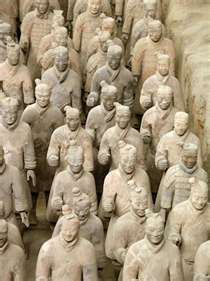
Internal strife marked the latter years of the Zhou Dynasty. Emerging out of the chaos was Shi-huang-di, the first of many emperors of China. Having unified the warring tribes, the emperor determined to keep the peace. In an attempt to keep out invaders, the emperor ordered hundreds of thousands of workers to construct a giant wall across China's northern border. This was the beginning of what is now called the Great Wall of China. In the emperor's time, it was more a collection of existing walls, fortified and augmented to include a network of smaller walls that incorporated natural defenses like rivers and high cliffs. As the emperor grew older, he pursued ways to stay alive forever. He visited a supposedly sacred island three times, searching for the legendary "elixir of life." Even though Shi-huang-di toward the end of his life had sought immortality, he had an insurance policy. Early in his reign as emperor, he had ordered a massive number of workers to create another building project, a giant mausoleum, where his body would be laid after death. Buried along with him were more than 7,000 terracotta warriors, guarding the emperor against future attack. These figures, armed and standing in battle formation, were accompanied in their vigil by hundreds of terracotta horses, battle chariots, and even underground palaces and towers. The famed Terracotta Army remained hidden for more than 2,000 years.
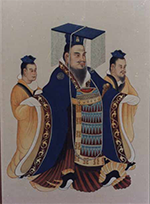
Filling the void left by the death of the first emperor were the rulers of the Han Dynasty, one of the most famous in Chinese history. One of the most well-known of the Han emperors was the first called Wu. Many historians consider Wu among China's greatest emperors. He ruled for 54 years and oversaw many significant developments, including the advent of the famous Silk Road. The network of trade routes stretched over land and sea, linking East and West at a time when Rome ruled the West. The Han period in China is known for its internecine struggles for power. However, this period of time in China was also an expansion of cultural awareness and technological achievements. Among the many firsts for the Chinese civilization was the invention of paper, in 105, by Cai Lun, and the completion of the first dictionary, by Xu Shen, five years earlier. As well, Han engineers crafted the earliest known method of printing with wooden blocks.
Following the Han were the Jin and the Northern and Southern Dynasties. Emperors Wen, Yang, and the Sui ruled all of China for three decades; among their accomplishments was the construction of the Grand Canal. Replacing them were one of China's most famous, the Tang.

Taizong was perhaps the most well-known of the Tang emperors, although Empress Wu was famous for his short-lived rule. Xuanzong ruled for four decades. Many historians refer to the Tang Dynasty as a golden era in Chinese history. Well-known inventions during this period included woodblock printing, enabling mass production of books of all kinds (including what is believed to be the earliest known book containing a date of printing, the Diamond Sutra (left)), and gunpowder, which was used for many years only for making fireworks. In the 8th Century, a Tang engineer, Yi Xing, created one of the world's first of what modern eyes would see as a mechanical clock. Other inventions credited to Tang engineers include air conditioning and gas stoves.
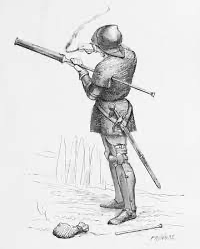
After the turmoil of the Period of the Five Dynasties and Ten Kingdoms came the stability brought by the Song Dynasty. A series of emperors, notably Taizu, ruled over a China that was rapidly expanding in many ways. The Northern Song fought wars against neighbors to the north, in the process creating China's first permanent navy. Song rulers ordered built paddle-wheel boats, which served as warships and also as escorts for an expanding merchant fleet, which sailed as far west as Arabia, delivering Chinese copper, porcelain, silk, tea, and other goods to the world. Guiding these ships on their journeys was an improved form of the compass, which scientists in Han times had invented. Song forces also deployed the relatively new weapon gunpowder to devastating effect. Song scientists increased their knowledge and understanding in engineering, mathematics, and technology. Among the advancements was the advent of movable type printing. Song forces fell to an outside force, the Mongols, led by Kublai Khan. His forces eventually conquered all of China, and Kublai declared the Yuan Dynasty.
During his reign, Kublai Khan promoted economic growth by encouraging building projects, of roads and buildings and canals, bolstering an already strong internal transport system. He created a central currency, called Chao; it was made of paper. More Westerners than ever before made their way east to Mongol lands. One of the most famous of these travelers was young Marco Polo. Yuan forces tried twice and spectacularly failed twice to conquer Japan. One of many internal uprisings, the Red Turban Rebellion proved the most successful, as its leader eventually overthrew a descendant of Kublai and declared himself the Hongwu Emperor, head of a new dynasty, the Ming.
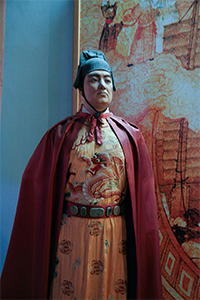
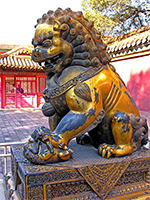
For nearly 300 years, Ming emperors oversaw a vast expansion in Chinese population, prestige, and influence. Perhaps the most famous of the Ming rulers was the Yongle Emperor, who oversaw the creation of the Forbidden City, a huge compound of imposing buildings, halls, gardens, bridges, pagodas, and canals–all enclosed by high walls and surrounded by a wide moat. This emperor also encouraged the voyages of Zheng He and his large fleet, which included some of the largest ships ever built and extended Chinese trade reach and prestige further than ever before. Later Ming rulers ordered a major refortification of the Great Wall, in order to forestall yet another Mongol invasion. It was from within that the last Ming ruler was defeated, giving way to China's last dynasty, the Qing.
Most well-known of the Qing rulers was the Kangxi Emperor, who sat on the throne for 61 years. Among his successes was the takeover of Taiwan; the signing of the Treaty of Nerchinsk, China's first with a European power; and the publication of the 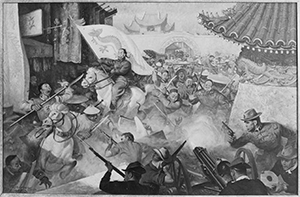 Kangxi Dictionary, China's first in centuries. His grandson, the Qianlong Emperor, ruled for 60 years and propelled China to its largest geographical extent, surpassing 5 million square miles. Subsequent emperors struggled to control an exploding trade in opium, which became the Opium Wars, twin conflicts that resulted in humiliating defeats for Chinese forces. Those and the Taiping Rebellion further weakened Qing control. By 1900 and the time of the Boxer Rebellion, Qing forces found themselves ill equipped to meet new challenges. The long years of rebellions, natural disasters (including a flood that killed 1 million people), famines (including two of the most devastating in world history), and external conflicts (military and political) had left the country in a severely imperiled state, ripe for one more uprising. That came against the Xuantong Emperor, a 2-year-old boy whose birth name was Puyi. Rebels led by Sun Yat-sen overthrew the empire in 1912 in a relatively bloodless manner and established a presidency-led new government. The Republic of China had its capital at Nanjing.
Kangxi Dictionary, China's first in centuries. His grandson, the Qianlong Emperor, ruled for 60 years and propelled China to its largest geographical extent, surpassing 5 million square miles. Subsequent emperors struggled to control an exploding trade in opium, which became the Opium Wars, twin conflicts that resulted in humiliating defeats for Chinese forces. Those and the Taiping Rebellion further weakened Qing control. By 1900 and the time of the Boxer Rebellion, Qing forces found themselves ill equipped to meet new challenges. The long years of rebellions, natural disasters (including a flood that killed 1 million people), famines (including two of the most devastating in world history), and external conflicts (military and political) had left the country in a severely imperiled state, ripe for one more uprising. That came against the Xuantong Emperor, a 2-year-old boy whose birth name was Puyi. Rebels led by Sun Yat-sen overthrew the empire in 1912 in a relatively bloodless manner and established a presidency-led new government. The Republic of China had its capital at Nanjing.
|
Search This Site
 Custom Search
|
Social Studies for Kids
copyright 2002�2020
David White
